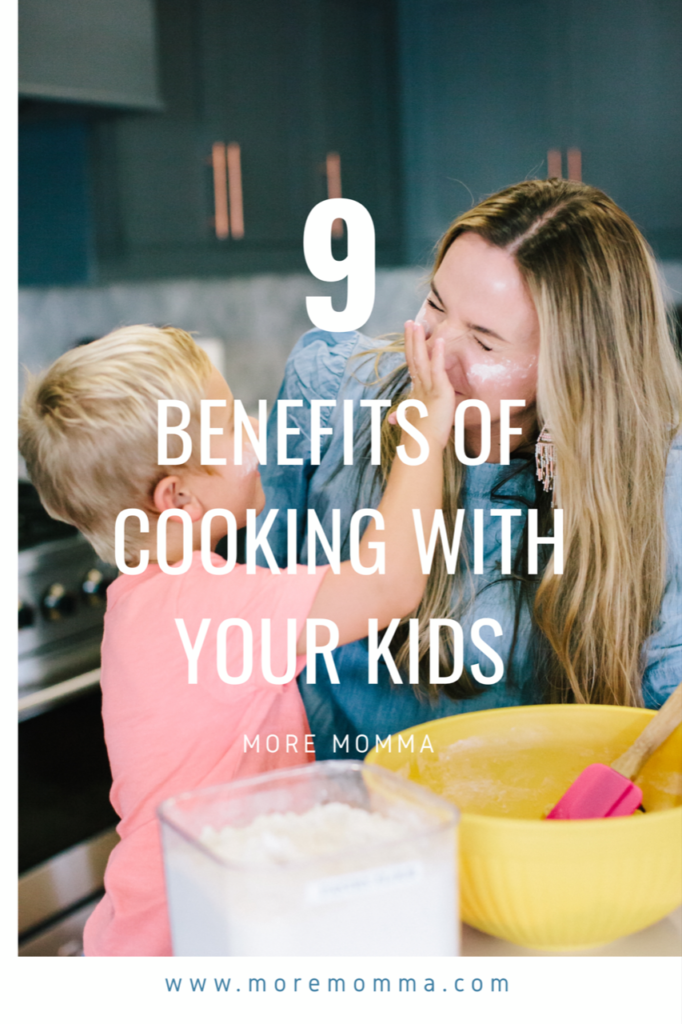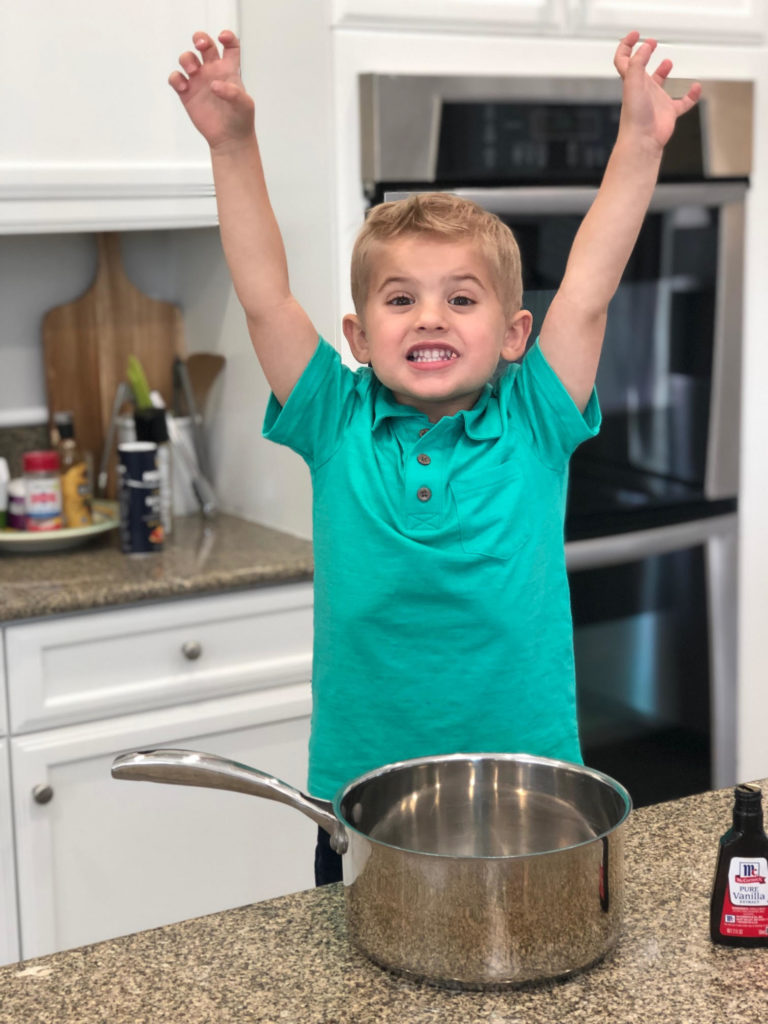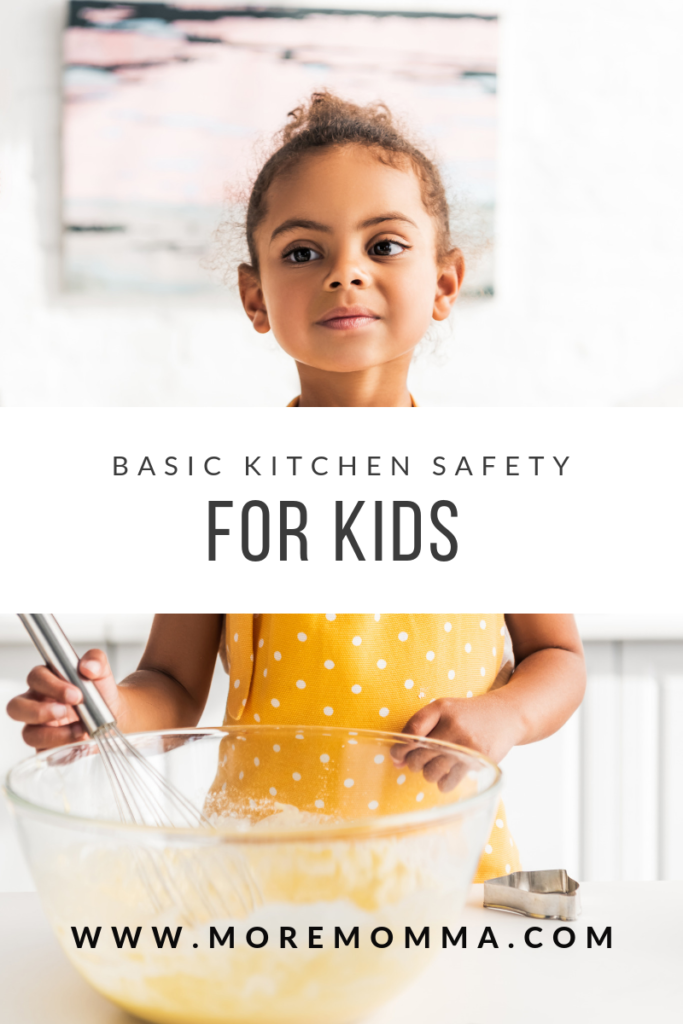Written by Meg Dow
This post was written to contribute to the topic of In the Home and Motherhood for the What Lola Likes blog by Meg Dow of More Momma. All facts, opinions, and professional tips are Meg’s.
I am so glad you are interested in getting your kiddos into the kitchen! It makes me happy to see parents with a desire to teach their kids cooking skills. It’s such a powerful tool that kids will have for the rest of their lives.

Nine Benefits of Cooking with Your Kids
There are so many benefits of cooking with kids. Here are some of the major benefits you will see if you get your kids in the kitchen with you.
- Bond and connect with your children: Some of my favorite memories as a child are cooking in the kitchen with my mom. I cherish those memories and I am grateful that she taught me how to cook and be self-sufficient.
- Engages all 5 senses: All of your senses are stimulated when you cook. You touch the food and experience different textures and temperatures. You smell different scents. You hear the sounds of cooking like sizzling, boiling and crunching. Plus, you see your masterpiece come together with the colors of the rainbow and finally you get to taste your creation, engaging your tastebuds. It’s a full body sensory experience!
- Teaches math, science and reading skills: Cooking is a great way to teach simple fractions, scientific reactions and reading. Have your children read a recipe to you and follow the steps. Create a science experiment by baking your favorite batch of cookies or homemade bread. Have your children half a recipe and learn fractions. The possibilities are endless.
- Reduces picky eating: If you have a picky eater, my number one tip to get them exposed to different foods is to have them cook with you. Getting your child involved in a happy kitchen can instill a huge sense of pride and accomplishment in them. If they are proud of what they make, chances are they will try it. You are also exposing them to different tastes, textures and smells while cooking. The more exposure, the better the eater.
- Develops fine motor skills: Stirring thick cookie dough, pouring a cup of oil, using a knife, squeezing a lemon — all of these simple tasks help develop fine motor skills.
- Gives children a sense of pride and accomplishment: The most important thing cooking teaches is the sense of self-sustainability and accomplishment. When your children can cook for themselves, they can one day provide that for their own families. What a blessing that can be! Cooking is an essential life skill that everyone needs to learn (no matter what age you are).
- Builds social and listening skills: Cooking together with family or friends can be one of the most enjoyable social experiences. So many times when I am teaching a kid’s cooking class, the students walk in feeling timid and shy, and by the end of it they are laughing, talking to one another and having fun. It can bring out the best in everyone. Moreover, listening to directions can make or break your recipe so letting them fail once in a while (if they aren’t listening) can be an impactful teaching moment.
- Therapeutic for many disabilities: Cooking can be a form of therapy. Because it involves all five senses, it is beneficial for those with disabilities. It’s currently being used as part of the treatment for a wide range of mental and behavioral health conditions, including depression, anxiety, eating disorders, ADHD and addiction.
- It’s an essential life skill for a healthy lifestyle: Teaching your children where food comes from, how it is prepared and what will help them feel their best creates a healthy relationship with food and a healthy lifestyle.

With all of these benefits, you must be wondering how to actually get your kids in the kitchen safely.
The first thing you want to teach your children is basic kitchen safety. The kitchen can be a fun and exciting place, but it also can be dangerous if children do not have set boundaries. If you have very young children, you can start teaching them kitchen safety with play time. Play kitchen or pretend to cook with them and teach them the basic rules in a fun and low-key environment.
Here are my basic safety tips for cooking with kids. Please add your own rules and do what makes you feel the most comfortable to ensure the safety of your children.

Basic Kitchen Safety:
- Wash hands with warm soapy water before you start cooking and after you have handled raw poultry, meat, seafood and eggs.
- Immediately clean cutting boards and utensils that come into contact with raw meat, fish, shellfish or eggs. Use separate cutting boards to not cross-contaminate these items.
- Make sure your child’s waist is level with the counter. You can use learning towers or safety stools to ensure they are enclosed and won’t fall off. Most accidents happen when children are not standing on a safe surface.
- My personal belief is that parents should turn on and off the stove until kids reach 10 years old.
- Have kids use the back burners of the stove to prevent burning or spilling hot liquids.
- Make sure all handles are faced to the side or back of the stove.
- Always have kids use oven mitts while putting things in the oven.
- Make sure they know basic safety information with appliances they are using before they use them.
Newborns:
Wear your baby in a carrier while you cook. This frees up your hands and allows your baby to be with you. Or have your baby sleep in a bouncer in the kitchen while you make dinner.

6-12 Month Olds:
Once your baby can sit up on their own, have them sit in a high chair or Bumbo and play with silicone spatulas or plastic measuring cups while you cook. Talk to your baby about what you are doing. Talk about the smells, the sounds and the taste of the food. In addition, have your baby try some of the foods you are preparing. Describe the color of the food is or how it tastes and feels.
1-2 Year Olds:
Have them start playing kitchen and using their imagination! I start teaching knife skills at this age by using a tool like this. You can have them sit on the kitchen floor while you cook. 1-2 year olds can play with pots, pans, tupperware, bowls and safe utensils.
2-3 Year Olds:
Have your child use a learning toweror safe stool with a back. Begin appropriate knife skills such as playing with a toy knife, cutting play dough with a plastic knife and cutting soft foods such as breads and pastries with a plastic knife using your guidance. Two to three year olds can do the following:
- Wash fruits and vegetables.
- Stir together ingredients.
- Use a rolling pin.
- Measure ingredients with your help.
- Pour ingredients into bowls.
- Spread butter or peanut butter on bread.
- Mash ingredients using the in-the-bag technique. Here is a great recipe for this!
- Use a hand juicer with your help.
4-7 Year Olds:
Assuming the previous skills are mastered, four to seven year olds can do the following in the kitchen:
- Help gather ingredients out of the fridge or pantry.
- Set the table.
- Start using the stove with supervision.
- Make simple meals such as sandwiches, eggs and pasta.
- Make their own lunch.
- Cut soft vegetables with a sharper knife.
If you are looking for knife recommendations, check out this post.
8-11 Year Olds:
Once the previous skills are mastered, I recommend having eight to eleven year olds do the following:
- Meal plan with you.
- Write out the grocery list.
- Be in charge of a dinner for a specific day of the week.
- Prep ingredients for the meal.
- Learn more advanced knife skills — they can use a paring knife or small chef’s knife.
- Use blenders, waffle machines, griddles, food processors, ice cream machines and other appliances.
- Learn how to double recipes and half recipes using fractions.
- Cook and bake some things on their own following a recipe.
Teens:
Teens can learn more advanced skills and do the following:
- Learn techniques such as frying, sautéing, braising, grilling and blanching.
- Make complete meals.
- Be creative and come up with flavor combinations.
- Repurpose leftovers.
- Budget for groceries.
- Coupon or find deals.
- Grocery shop.
- Host a meal.
- Learn different types of cuisines.
- Eat at different types of restaurants with various cuisines.
Making Cooking With Kids Less Stressful:
You have 10 minutes to get dinner on the table and your family has activities for the next 4 hours with sports, extracurricular events and meetings. Then your five year old asks you if he can make dinner with you. What do you do? Don’t worry momma, I got you! This happens to me all the time. I have found a few tricks to get them involved even if you don’t have the extra time to walk them through an entire recipe.
Some great options when you really just don’t have extra time or patience is to have them do something that is unrelated to the meal like….
- Wash fruits and vegetables that you picked up from the store (even if they have washed them before).
- Help you gather ingredients.
- Organize a part of the pantry.
- Set the table.
- Start to help make lunches for the next day.
- Pick out their snacks for the next day.
- Wash dishes.
- Put the dishes in the dishwasher.
- Be in charge of cleaning up as you go.
Whether you have five minutes or 50 minutes to make dinner for you and your family, I encourage you to get them in the kitchen with you. The time and memories you will make are priceless. In addition, the life skills you will be teaching them is something that can be passed on from generation to generation. If you are struggling with meal time or just need tangible ways with recipes to get your kids involved, check out the More Momma Supper Club. You can use code LOLA10 to get 10% off these family-friendly meal plans with grocery lists and all.
Happy Cooking Friends!

MEG DOW
Meg has worked as a private chef and caterer for over 12 years. She has also worked at one of the top restaurant consulting firms in the world opening up and creating menus for dozens of restaurants. She quit her consulting job as the Head Chef of Recipe and Development to start her family. After her second child was born she felt a deep desire to help other moms in her same position to get meals on the table for their families. She started More Momma and has loved every second of the journey!
VISIT HER PAGE
